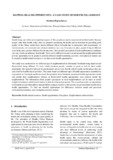Please use this identifier to cite or link to this item:
https://elibrary.khec.edu.np:8080/handle/123456789/170| Title: | MAPPING HEALTH OPPORTUNITY: A CASE STUDY OF DORTMUND, GERMANY |
| Authors: | Bajracharya, Sushma |
| Keywords: | Health related resources, Health opportunities, Perception, Neighbourhood characteristics. |
| Issue Date: | Apr-2019 |
| Abstract: | Health being one of the most important aspects of life, people are much concerned about their health. Because people value their health, today cities are planned considering the health and environment for providing good quality of life. Many studies have shown different effects in health due to interaction with environment. As socioeconomic, environmental and cultural conditions may vary from place to place, people living in different areasin the cities can have different health outcomes. Also, people's perception ofsuch neighbourhood conditions can vary which can influence their health. There can be different resources in and around the neighbourhood that provide opportunity for its people to perform different health-benefitting activities. Such physical features can be termed as health-related resources or in other words health opportunities. This study was conducted in two different type of neighbourhoods in Dortmund, Nordstadt being deprived and Kreuzviertel being affluent. To know which locations people, consider as good or bad for their health, participants who agreed to take part in questionnaire survey were directly asked to point out the places they use and avoid for health-related activities. This study found out different types of health opportunities identified by respondents in Nordstadt and Kreuzviertel. Respondents from Nordstadt mentioned health opportunities inside and outside their neighbourhood whereas in Kreuzviertel health opportunities were pointed outside the neighbourhood. The information about people's perception on local neighbourhood can be taken as useful insights for planners and decision-makers to plan development programs. The research provides an opportunity to formulate policies that address main problems acting as barriers so that people can get maximum benefits from health opportunities. To find out detailed explanations for differences between actual and perceived environmental situation, more in-depth research is needed. |
| URI: | https://doi.org/10.3126/jsce.v6i0.23965 |
| ISSN: | 2091—1475 (Print) 2645-8518 (Online) |
| Appears in Collections: | Journal of Science and Engineering Vol.6 |
Files in This Item:
| File | Description | Size | Format | |
|---|---|---|---|---|
| 6_Sushma_Bajracharya.pdf | 2.73 MB | Adobe PDF |  View/Open |
Items in DSpace are protected by copyright, with all rights reserved, unless otherwise indicated.
